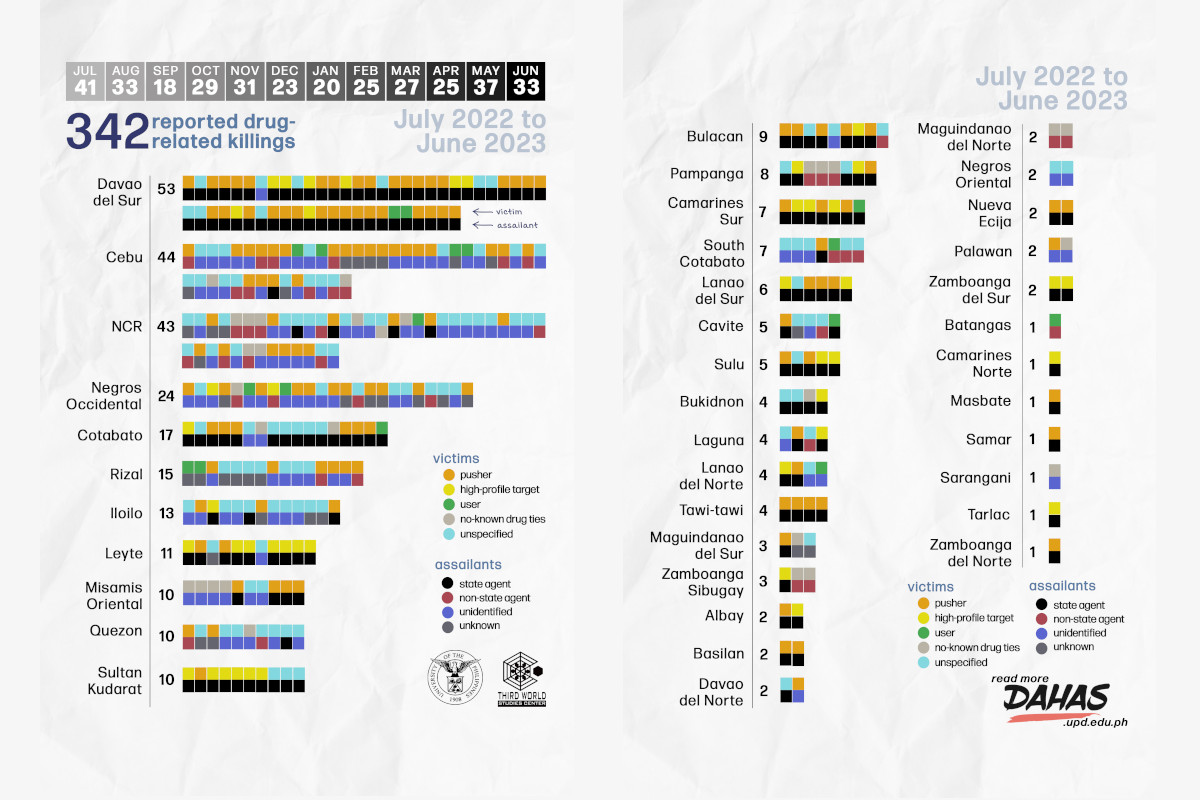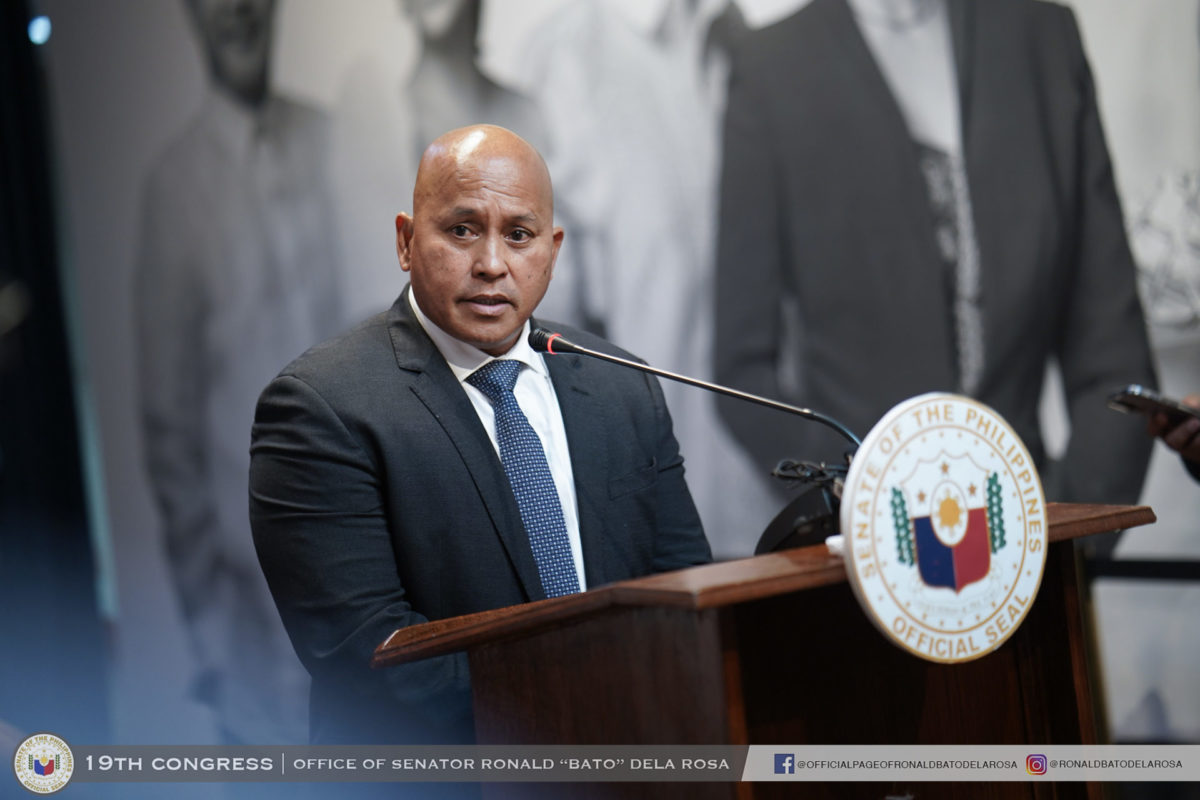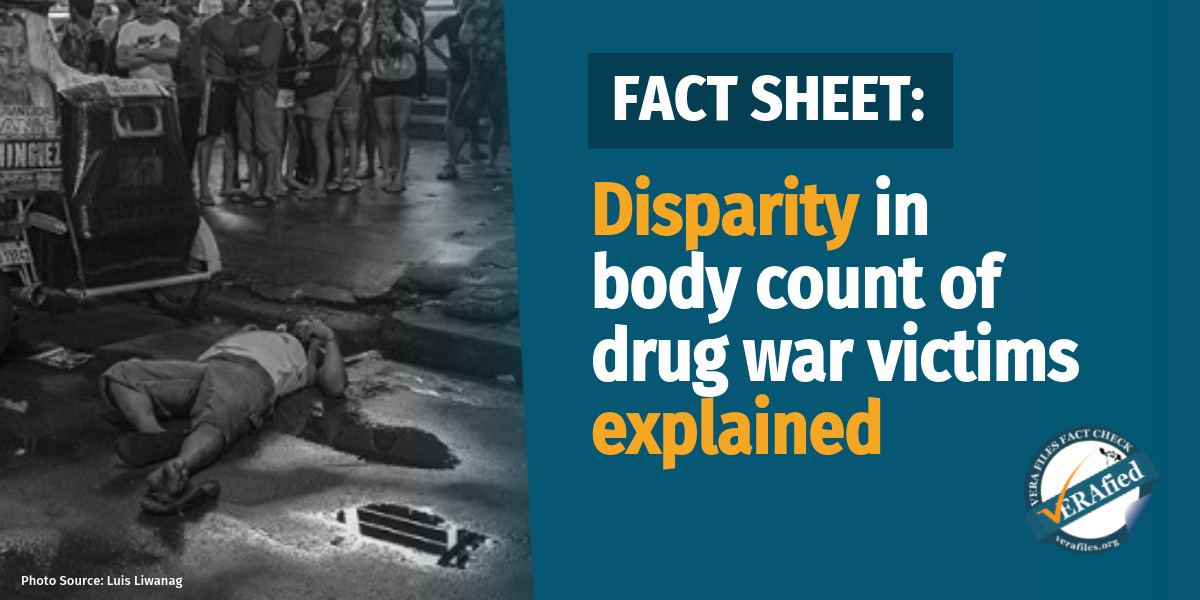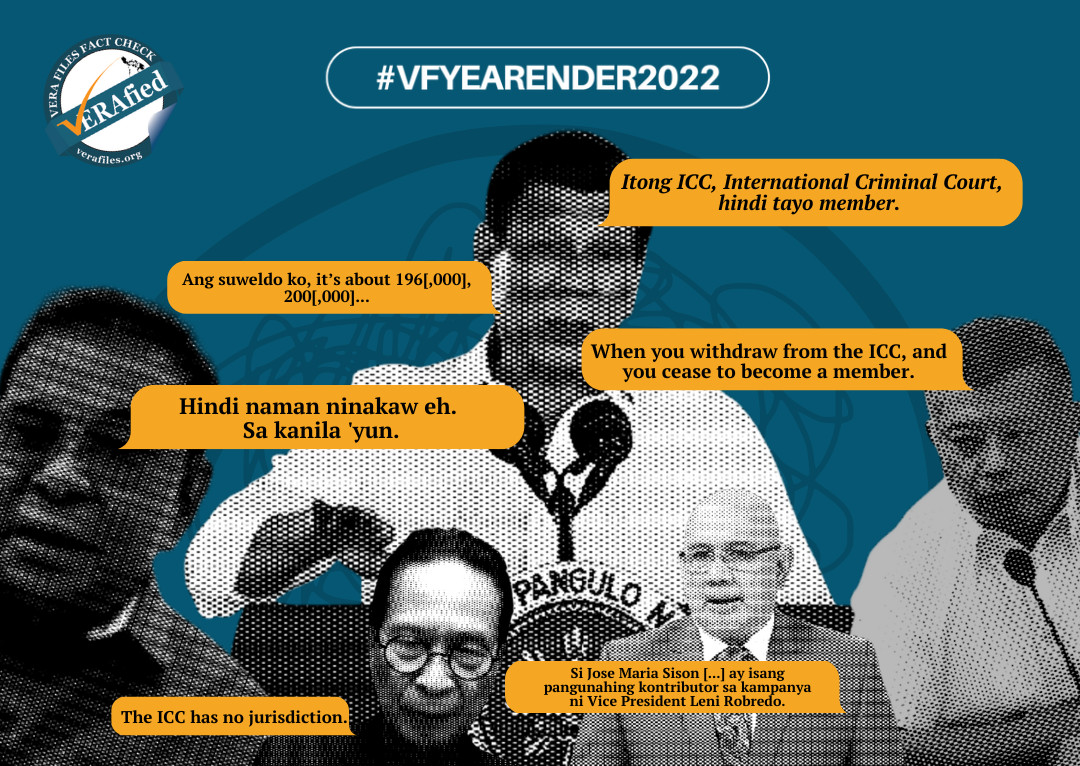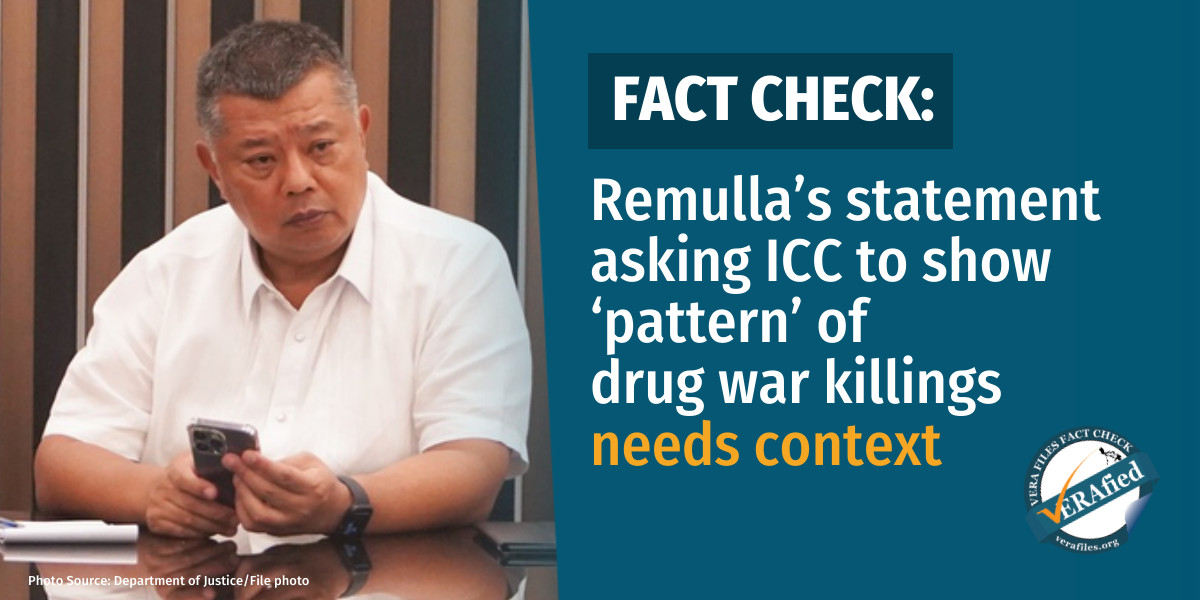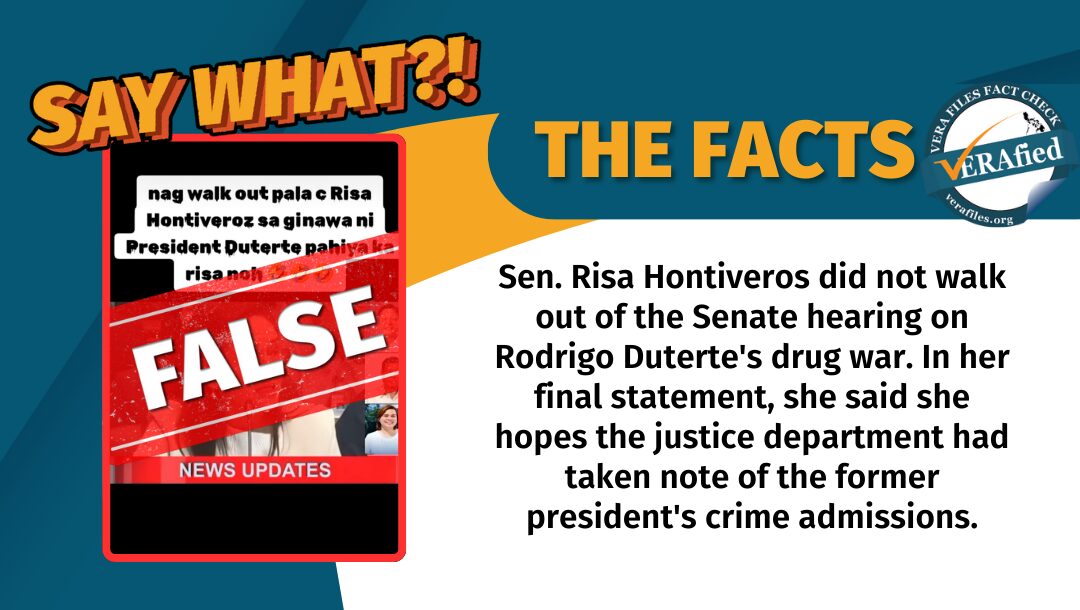Davao City has emerged as the top hotspot for drug-related killings, a report by the University of the Philippines Third World Studies showed.
Under the leadership of Sebastian “Baste” Duterte, son of the former president Rodrigo Duterte, whose administration was notorious for its bloody war on drugs, Davao City has seen a staggering rise in the rate of drug-related killings.
This is based on the report by the Dahas Project of the Third World Studies Center, a research unit of the College of Social Sciences and Philosophy, University of the Philippines Diliman. Dahas collects media reports on drug-related killings, most of which are first reported through local news outlets.
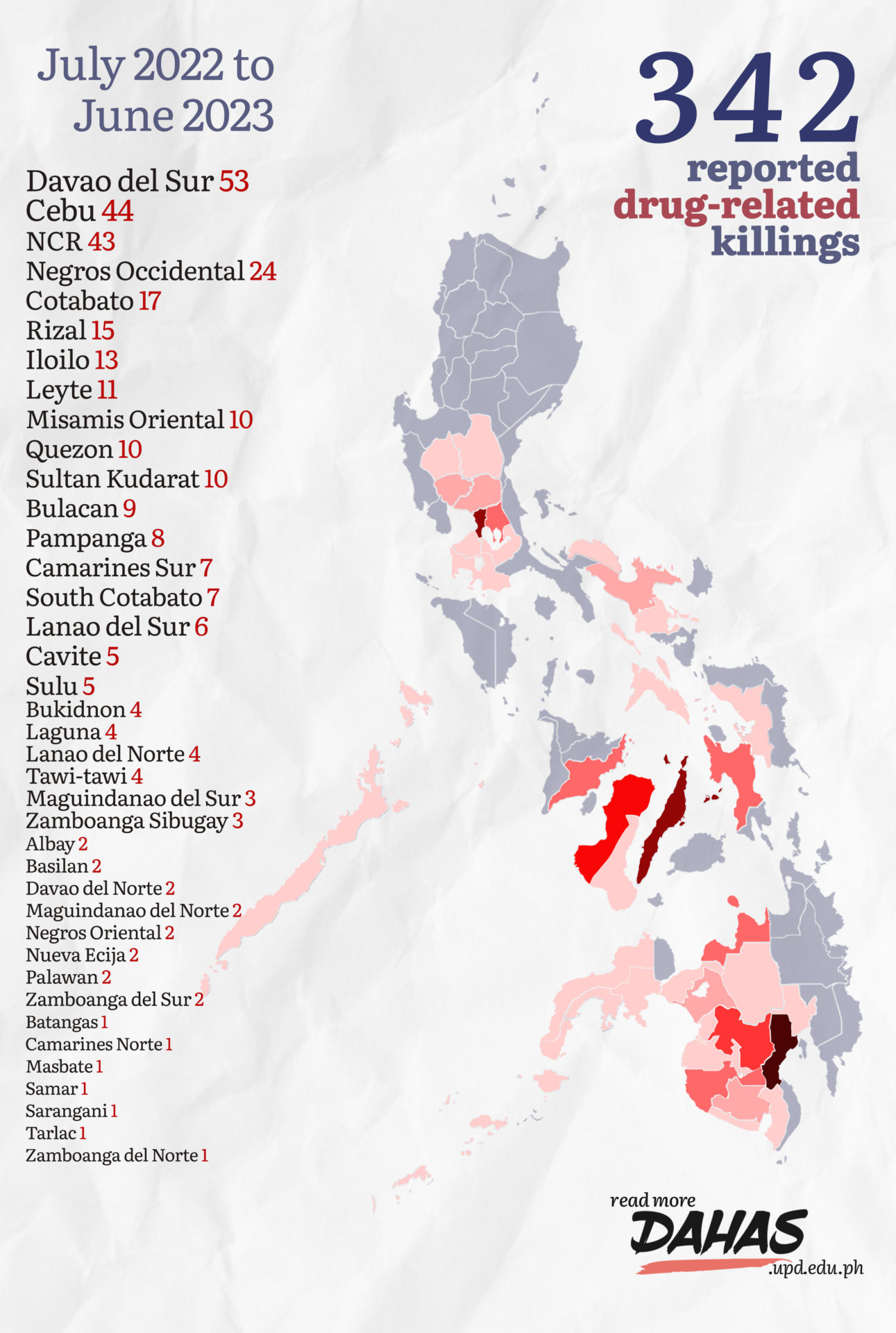
Grim numbers
Out of the 342 drug-related casualties recorded in the first year of the Marcos administration ( July 1, 2022 – June 30, 2023) 53 or 15% were concentrated in Davao City in Davao del Sur, at an average of one killed per week, topping all other provinces in the country such as Cebu with 44, and Metro Manila with 41.
The profile of the casualties generally follow the trend observed for all the killings in the country. All of them were male, and 27 or 51% were in their 20s and 30s. Six or 11% were in their 40s, two or four percent in their 50s, and there were 17 whose ages were not specified in the reports.
On August 25, 2022, a minor was killed, a 17 year-old identified only as “Bulhog.” The police claimed that he had been in and out of jails and detention centers since he was 10 years old and was a known thief in Bankerohan. “Bulhog” died in the now usual nanlaban fashion during a buy-bust. Noticing he was transacting with the police, he fired at them, forcing the cops to retaliate and kill him. The police recovered from his corpse a .38 caliber revolver, 22 grams of marijuana worth PHP 12,000.00, and shabu worth PHP 3,000.00.
Pushers, street-level drug peddlers continue to make up the majority of those killed, accounting for 34 or 64% of drug-related deaths in Davao City. In contrast, big time drug dealers make up 15% or 8 people killed. Nine individuals or 17% had no reported involvement in the drug trade, and there were 2 who were reportedly users of illegal drugs.
Of the 53 killed, 47 were reportedly in possession of illegal drugs, mostly just shabu, occasionally marijuana, and in some instances, both. The unit used to report the amount of drugs recovered from the killings varies, from the drugs’ specific weight in grams to just the number of sachets or packets seized.
Higher prices of shabu in Davao
In 22 of the incidents reporting the recovery of shabu from the killed suspect, the amount of drugs were given in grams. In total, 193.75 grams were recovered from these incidents, with the weight per incident ranging from 0.65 grams to 45 grams. This is an average of 8.9 grams per incident, with 17 of the 22 killed found possessing less than the average.
Currently, the Dangerous Drugs Board (DDB) estimates the street value of shabu at ₱6,800.00 per gram. In the Dahas database, despite variations, the most recurring rate is ₱16,000.00 per gram. According to the spokesperson of PDEA-11, which covers the Davao region, shabu in Davao City is pegged at a much higher price. He claims that this is due to the dwindling supply of shabu resulting from the checkpoints they established that made entry for peddlers much harder.
Forty-five (86%) of the victims were found in possession of a firearm, allegedly used to shoot at the police in the course of a buy-bust operation.
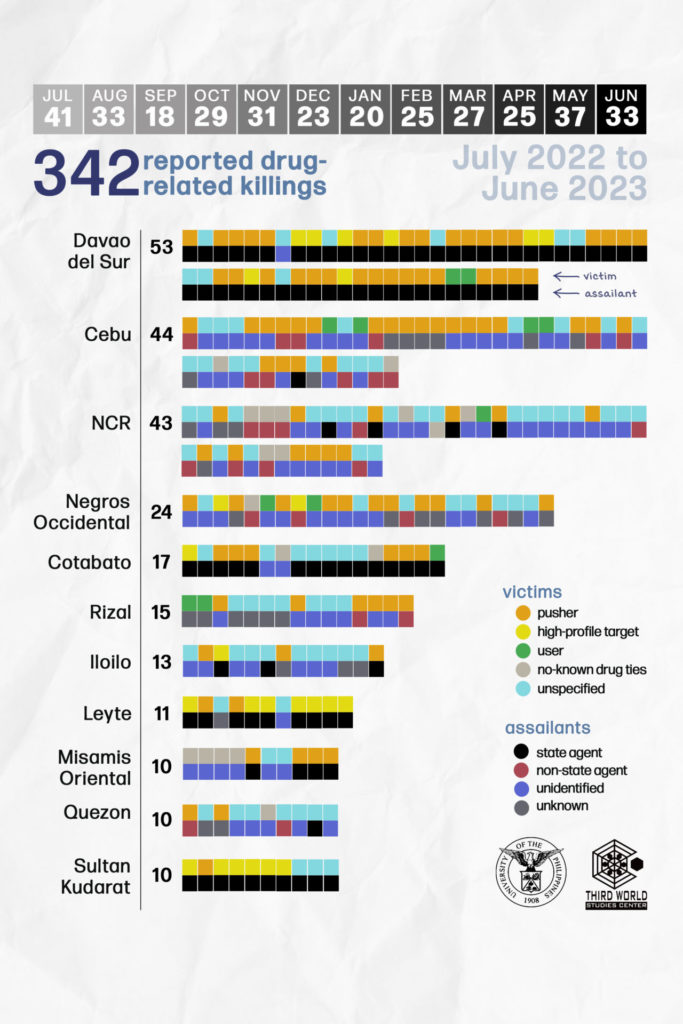
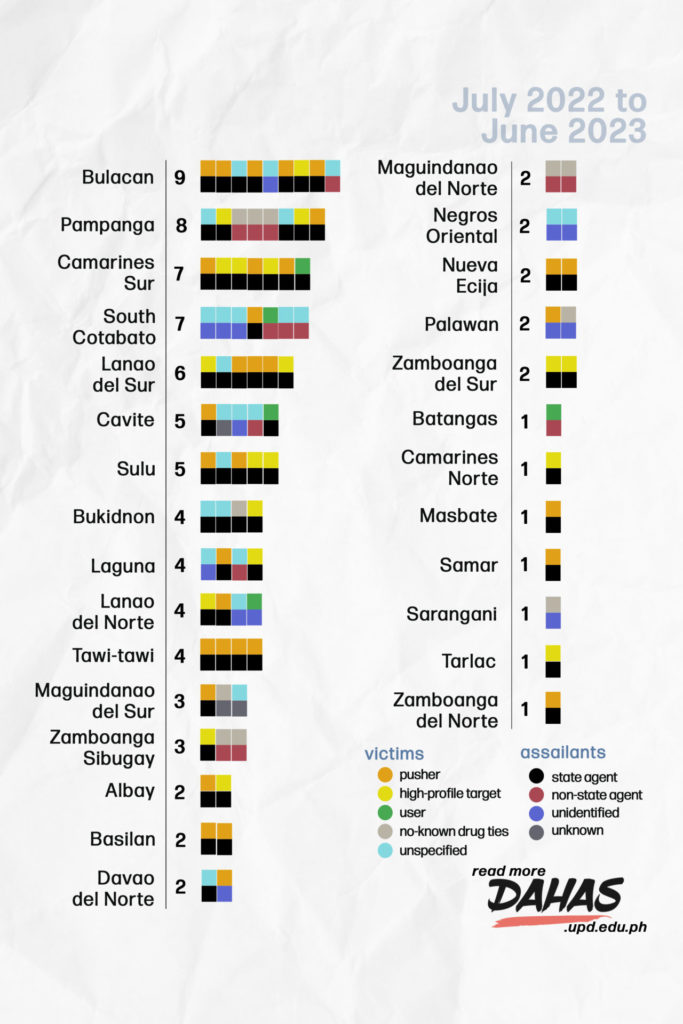
Figure 2. Reported Drug-Related Killings in the Philippines Indicating Victim and Assailant, July 2022-June 2023
State agents’ involvement
Other than the concentration of the killings in Davao City, another peculiar feature of these fatalities is that all but one were killed by state agents. Whereas in Cebu and NCR, the two other hotspots, non-state elements were predominantly responsible for most of the fatalities.
Out of 52 who were killed by state agents, 40 or 75% were in planned anti-drug operations while 12 or 23% were from unplanned operations because of alleged robbery and theft, sexual assault, or criminal gang involvement, which led to the death of a person with alleged links to illegal drugs. All 52 were operations carried out by the PNP, and in three jointly with PDEA. The lone exception was Joel Alkuino Lim, a construction worker with a pending court case for illegal drugs, who was shot in close range by an unidentified assailant while riding a taxi cab.
In an interview for the declaration of 14 Davao City barangays as drug-cleared in September 2022, PDEA-Davao spokesperson Noli Dimaandal stated that in comparison to other areas in Davao, downtown Davao City is still a “drug-affected area.”
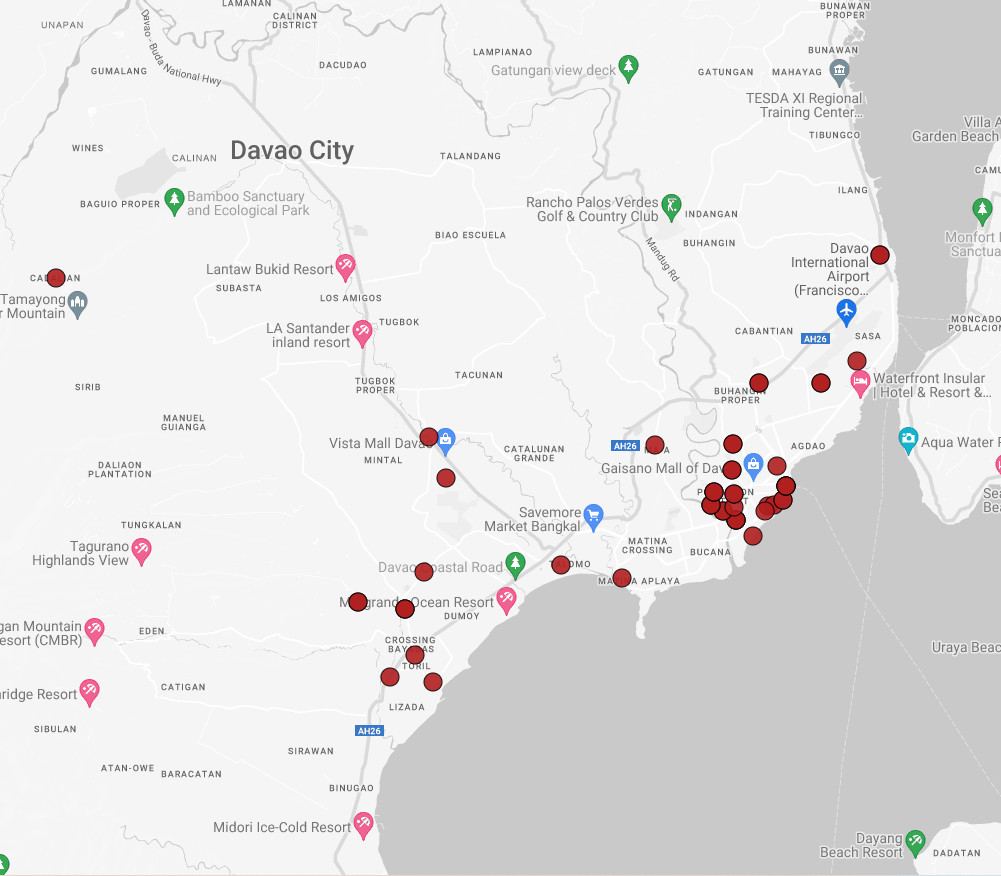
Deadly Davao City coastline
Mapping out the 53 drug-related deaths from July 1, 2022 to June 30, 2023 shows a concentration in the coastline areas of Davao City, particularly in Poblacion District—the largest in Davao City covering 40 barangays—where 22 out of 53 killings occurred. The lone outlier is the case of Vicente Latonio Gabi in Baguio District, who was killed in a hot pursuit operation while fleeing the scene on his motorcycle.
In a press conference on July 19, 2023, the head of the City Anti-Drug Abuse Council (CADAC) declared that many of its barangays failed to receive a drug-cleared status for 2022. Out of its 182 barangays, 83 or 46% failed in complying with the city’s clearing program. Two reasons were cited for the difficulty in achieving a drug-cleared status in these barangays: First, consistent with the marked locations of the killings, these barangays are located in the city’s coastline where border controls are harder to establish, and second, these barangays were said to lack sufficient proficiency in governance, resulting in difficulties in holding officials accountable.
In response, many of the barangays argue that they are cautious in declaring areas as drug-free. Given the influx of people in these areas, these barangays fear the possibility of illegal substances entering along with the crowd, thereby causing any declarations of a drug-free barangay to be revoked.
While made apparent in the said press conference that efforts are being made to achieve a drug-cleared status, the relative scale of drug-related violence in the city, particularly those coming from law enforcement operations, is left unexplained.
Information about the drug-related killings may have been left unexplained, but the police force made social media posts about some of the killings. This gives credence to the perception that the police still derive some propaganda value from their own death work.
Yet the news of the drug-related killings seem to have been confined to the reach of the local press and the police network. Only a few of the killings landed in national news.
Out of the 53 cases, 19 are posted on social media pages of the Davao City Police Offices, Davao Police Regional Office, or even PNP’s own Facebook page. Since information on buy-bust operations and Tokhang and Project Double Barrel Personalities are listed exemptions to the PNP Freedom of Information (FOI), obtaining data on drug-related deaths is highly reliant on the availability of media coverage. There are a lot of cases however, that do not reach national mainstream media and are only covered by a few—or sometimes singular—local news outlets. Hence, undercounting is a possibility.
| Name | Facebook Post (Local precinct) | Facebook Post (Regional / National command) | With local news report | With national news report | |
| 1 | Julemer Bendulo | ✗ | ✔ | ✔ | ✔ |
| 2 | Roberto “Pabling” Delante | ✗ | ✗ | ✔ | ✗ |
| 3 | “Darwin” | ✗ | ✗ | ✔ | ✗ |
| 4 | Allan Tancio | ✗ | ✗ | ✔ | ✗ |
| 5 | “Bulhog” | ✗ | ✗ | ✔ | ✗ |
| 6 | Regie Alegado | ✗ | ✗ | ✔ | ✗ |
| 7 | Joel Alkuino Lim | ✗ | ✗ | ✔ | ✗ |
| 8 | Hideki “Diki” Hernando | ✔ | ✗ | ✔ | ✗ |
| 9 | Arryson “Arison” Cordova | ✗ | ✗ | ✔ | ✗ |
| 10 | Aaron Kyle Tamano | ✗ | ✗ | ✔ | ✗ |
| 11 | Alvin Makiling | ✗ | ✔ | ✔ | ✔ |
| 12 | Ricardo Alvarado “Bading” Dabal | ✔ | ✗ | ✔ | ✗ |
| 13 | “Jay-R” | ✔ | ✗ | ✔ | ✗ |
| 14 | John Archie “Archi” Araula | ✔ | ✗ | ✔ | ✗ |
| 15 | Karding Tisoy | ✔ | ✔ | ✔ | ✗ |
| 16 | Berjorie “Ding” Bayron | ✔ | ✗ | ✔ | ✗ |
| 17 | “Kenny” | ✔ | ✗ | ✔ | ✗ |
| 18 | Tito Pansian “Tito” Aniscal | ✗ | ✗ | ✔ | ✗ |
| 19 | Junrey Lulu Matulin | ✗ | ✗ | ✔ | ✗ |
| 20 | Lulie Sumalpong | ✗ | ✗ | ✔ | ✗ |
| 21 | Joseph de Veza Hinggosa | ✗ | ✗ | ✔ | ✗ |
| 22 | “Bobet” | ✗ | ✗ | ✔ | ✗ |
| 23 | Rodel Omega “Rodel” Enad | ✔ | ✗ | ✔ | ✗ |
| 24 | Ronel Ladiagonong “Ronel” Onatan | ✗ | ✗ | ✔ | ✗ |
| 25 | Vicente Latonio Gabin | ✗ | ✗ | ✔ | ✔ |
| 26 | Unidentified | ✗ | ✗ | ✔ | ✗ |
| 27 | Edezon Tubiran “Edison” Cabarubias | ✗ | ✗ | ✔ | ✗ |
| 28 | Alberto Solomon | ✗ | ✗ | ✔ | ✗ |
| 29 | “Nonat” | ✗ | ✔ | ✔ | ✗ |
| 30 | “Ron-Ron” | ✗ | ✔ | ✔ | ✗ |
| 31 | “Migo” | ✔ | ✗ | ✔ | ✗ |
| 32 | Jestino Sardido Saban | ✗ | ✗ | ✔ | ✔ |
| 33 | “Pakay” | ✗ | ✗ | ✔ | ✔ |
| 34 | “Ding-Ding” | ✗ | ✗ | ✔ | ✗ |
| 35 | Antonio Guerra “Taba” Araño | ✗ | ✗ | ✔ | ✗ |
| 36 | Nicole “Nikoy” Majadas | ✗ | ✗ | ✔ | ✗ |
| 37 | Ivan Ermac “Ivan” Palma | ✗ | ✗ | ✔ | ✗ |
| 38 | “Dodong” | ✔ | ✗ | ✔ | ✗ |
| 39 | “Bert” | ✗ | ✗ | ✔ | ✗ |
| 40 | Omar “Mar” Polpol Barayman | ✔ | ✗ | ✔ | ✗ |
| 41 | Jumar “Mar” Lumanding | ✗ | ✗ | ✔ | ✗ |
| 42 | Jasper Gomez | ✗ | ✗ | ✔ | ✗ |
| 43 | “Omar” | ✗ | ✗ | ✔ | ✗ |
| 44 | John Rey “Part” Dedoro | ✔ | ✗ | ✔ | ✗ |
| 45 | Romeo Urmenita “Jun Bas” Bas | ✗ | ✗ | ✔ | ✗ |
| 46 | Geoffrey Quano “Amo” Catibod | ✗ | ✗ | ✔ | ✗ |
| 47 | Francis Miguel “Migi” Conjorado | ✗ | ✗ | ✔ | ✗ |
| 48 | Dennis | ✗ | ✗ | ✔ | ✔ |
| 49 | Mark Pabellon | ✔ | ✗ | ✔ | ✔ |
| 50 | “Balong” | ✗ | ✗ | ✔ | ✗ |
| 51 | “Emat” | ✗ | ✗ | ✔ | ✗ |
| 52 | “Manny” | ✔ | ✗ | ✔ | ✗ |
| 53 | John Roy delos Santos “Gamay” Badayos | ✔ | ✗ | ✔ | ✔ |
Update on Davao city drug war
In November 2022, the Davao City LGU was chosen as representative of Southern Mindanao for the regional launches of the Buhay Ingatan, Droga’y Ayawan (BIDA) program. The program promises to adopt a framework focusing on rehabilitation and socio-economic development, a tangent from Duterte’s heavy-handed law enforcement despite the Marcos-Duterte alliance.
Baste Duterte is the Davao Region Peace and Order Council Chair .
Based on the latest monitoring of DahasPH last July 23, 2023, killings continue to turn up in Davao City, still by state agents. So far, 7 have been killed, still in downtown Davao City, in the districts of Poblacion (3), Toril (2), Tugbok (1), and Agdao (1) since July 1, 2023, the start of the second presidential year of Marcos Jr. The current rate is now two killings a week.
In his 2023 State of the Nation Address last July 24, Pres. Ferdinand “Bongbong” R. Marcos Jr. boasted that “the campaign against illegal drugs continues, but it has taken on a new face,” and that it is “geared towards community-based treatment, rehabilitation, education, and reintegration, to curb drug dependence among our affected citizenry.”
In Duterte country, the “new face” of Marcos’s drug war effort eerily still resembles what the Dutertes have long imprinted on their turf.
(Marion Abilene R. Navarro and Nixcharl C. Noriega are researchers at the Third World Studies Center, College of Social Sciences and Philosophy, University of the Philippines Diliman. Third World Studies Center interns, Jewel Christopher Politico and Frey Aura D. Galario helped prepare the table to compare reports on drug-related deaths in Davao City from July 1, 2022 to June 30, 2023.)
